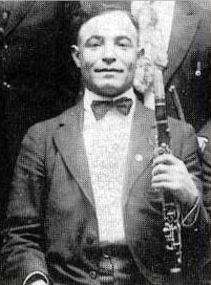Naftule Brandwein
Naftule Brandwein, or Naftuli Brandwine, (1884–1963) was a Jewish clarinetist and influential klezmer musician.
Naftule Brandwein | |
|---|---|
 | |
| Background information | |
| Born | 1884 Przemyslany, Austria-Hungary |
| Died | 1963 |
| Genres | Klezmer |
| Instruments | Clarinet |
Biography
Early life
Brandwein was born in Przemyslany, Austro-Hungarian Galicia (now Ukraine), into a family of klezmer musicians, part of the Stretiner Hasidic dynasty founded by Rabbi Yehuda Hirsch Brandwein of Stratin. His father Peysekhe played violin and was an improvising wedding poet (badkhn); of his thirteen sons, Moyshe played violin, French horn, and valve trombone, Mendel played piano, Leyzer played drums, and Azriel played cornet; Azriel became Naftule's first music teacher, and had a lasting impact on his playing.
Emigration to the United States
In 1908 Brandwein emigrated at the age of nineteen to the United States where he quickly became a star of the 78 rpm record era, proclaiming himself the "King of Jewish Music". Thus, he was considered to be among the first wave of American klezmer artists, those trained in the Old World, as opposed to the second generation who learned their skills in America. Between 1922 and 1927, he cut twenty-four records, first as a member of Abe Schwartz's orchestra, and then as a solo artist after 1923.
Decline
His career soured from the mid-1920s onward, as demand for his traditional approach to klezmer music waned; he made his last recording in 1941 and lived out his final years in relative obscurity, playing in the Borscht Belt.
Style
Brandwein was known as much for his colorful personality as for his musical talent, sometimes playing with a neon sign, reading "Naftule Brandwein Orchestra", around his neck, and with his back facing the audience, to conceal his fingering tricks. He also wore plugged-in Christmas lights as part of his costume on several occasions, which once shorted out when he perspired too much, almost electrocuting him. His wild style incorporated the many strands of Eastern European Jewish music which was influenced by Greek, Turkish, Hungarian and Gypsy music. His warm and lively playing style would constantly jump up and down the scale and express itself in trills, slides and other ornamentation; he is often contrasted to the other famous klezmer clarinettist of his time, Dave Tarras, who had a different style of sound and phrasing.
Legacy
While he did not live to witness the resurgence of interest in klezmer that began in the mid-1970s, his legacy has been revived by a new generation of klezmer musicians, who cite him as a key source of inspiration. The intricate traditions of klezmer music are not well preserved in sheet music, and his recordings are one of the main sources people look to for the "original" klezmer style.
Recordings
- 1997: King of the Klezmer Clarinet
Homage
- 2008: Yom New King of Klezmer Clarinet (A tribute to Naftule Brandwein) (reviewed on Klezmer Podcast by Keith Wolzinger)
External links
References
- Henry Sapoznik, liner notes for King of the Klezmer Clarinet.